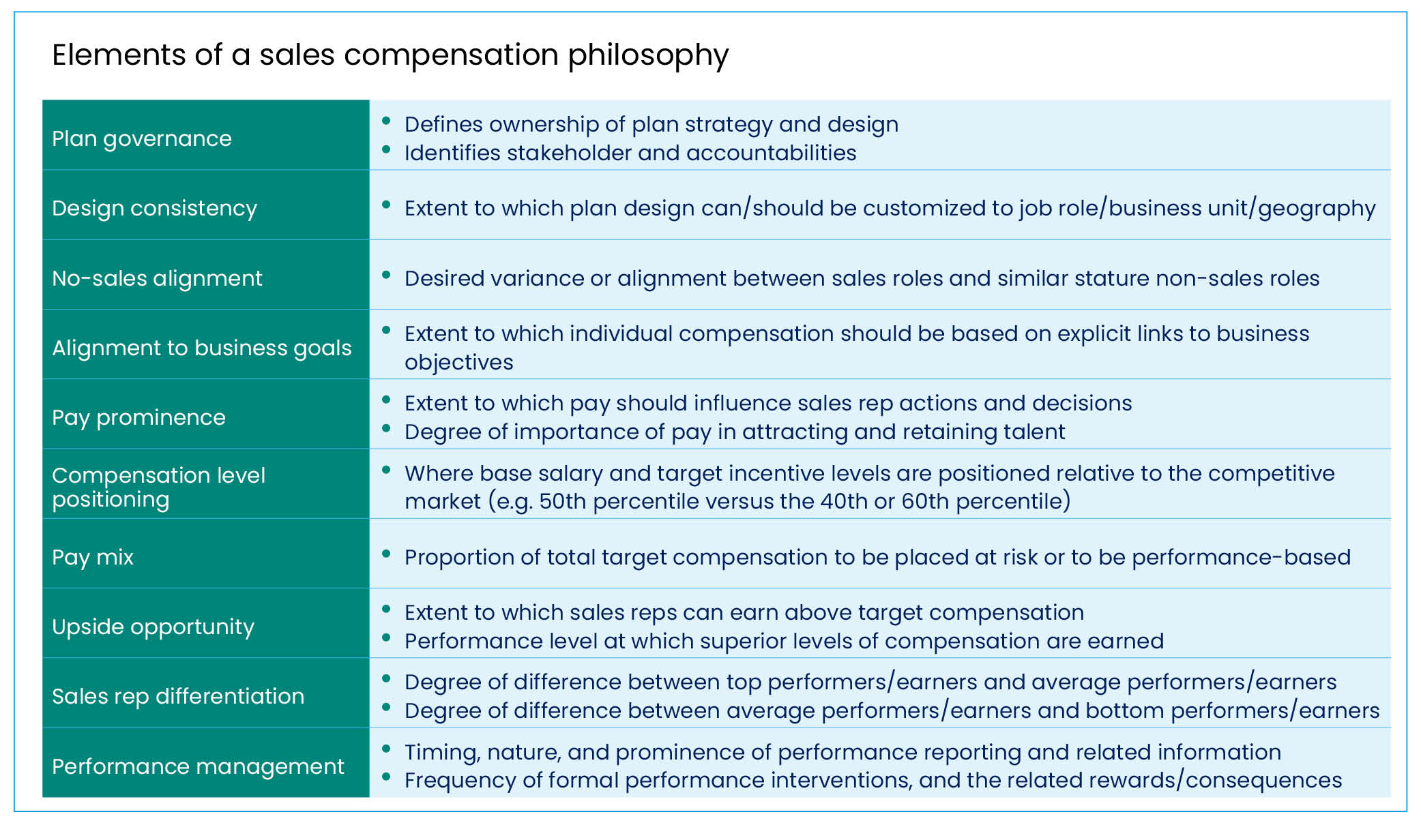- The key to success. There are 10 elements of a sales compensation philosophy that help define the key parameters of a program.
- Consider plan governance. Creating explicit ownership for sales compensation outside of a design effort is a strategic decision, rather than a “who has the manpower for sales comp this year” discussion. Creating a decision-rights matrix can clearly articulate plan governance accountabilities.
- Alignment to business goals. This will most directly affect plan mechanic decisions. True alignment between rep earnings and business goals is best achieved via a quota-based compensation plan.
- Performance management. An organization’s point of view on ongoing performance coaching, performance reporting and formal feedback delivery should be tightly integrated with the compensation program, and as such must be included in the sales compensation philosophy.
A sales compensation philosophy is the foundation upon which specific compensation design decisions are based. As a statement of the sales compensation strategy for an organization, the compensation philosophy can provide the framework for a successful compensation design effort.
There are 10 elements of a sales compensation philosophy that help define the key parameters of a program.

10 Elements of Governance
Plan Governance
Sales compensation strategy and design issues typically involve a number of corporate functions and business unit teams. These teams may include sales operations, the sales organization itself, human resources and occasionally finance. As a link between sales and compensation, it is very common for sales compensation to have shared ownership between one or more of the listed functions.
Creating explicit ownership for sales compensation outside of a design effort is a strategic decision rather than a “who has the manpower for sales comp this year” discussion. Creating a decision-rights matrix can clearly articulate plan governance accountabilities.
Design Consistency
Sales compensation designs need to be customized to fit each individual selling role. That being said, some degree of alignment across sales roles may be desirable. Having similar measures, for example, clearly communicates that a few performance measures are important to the organization, regardless of job roles. The sales compensation philosophy should articulate the business’ objectives for alignment across roles in terms of measurement and mechanics.
Non-Sales Alignment
It is important that the compensation strategy (and particularly total target compensation levels) should be aligned with similarly leveled non-sales jobs. The relationship between sales and non-sales compensation unambiguously communicates the relative importance of sales to the success of the business.
If the organization is not driven by sales, but rather by new product development or operational excellence, then the sales compensation philosophy and approach need to be adjusted accordingly.
Alignment to Business Goals
A sales compensation program needs to be aligned with key business objectives. What is less universally agreed upon, though, is the extent to which the attainment of individual and corporate goals explicitly affect rep earnings levels.
In the most direct fashion, this will have an impact on plan mechanical decisions: true alignment between rep earnings and business goals is best achieved via a quota-based compensation plan.
Pay Prominence
Not all sales organizations want compensation to play a strong role in influencing rep behavior. Clearly stating the intended prominence of sales compensation defines upfront how much of a sales rep’s day-to-day actions should be tied to the compensation plan.
Furthermore, compensation is only one element of the overall relationship between the sales rep and the company. There may be other, more compelling or important elements (e.g., benefits, career progression, work content and company affiliation) than can be more effective talent management tools. As a result, compensation needs not be as prominent.
Compensation Level Positioning
There are a number of business-based factors that can affect where target compensation levels should be positioned relative to some external benchmark. Apply logic and results to a target compensation level that accurately reflects the needs of the business rather than simply the pay levels of your competitors.
Pay Mix
The proportion of compensation that is performance-based, whether it is via commissions bonus, or some other mechanic, can vary significantly across sales jobs and industries. The role of the sales rep in the sales process, is the textbook driver of pay mix. The prominence of a sales rep, or the degree of control a rep exhibits over the sale, suggests an appropriate amount of compensation to be placed at risk. The more prominence a rep has over the sale, the more pay at risk.
Upside Opportunity
The term upside is used to describe the opportunity to earn compensation in excess of the target. To place some terminology and mechanics behind this concept, upside is commonly quantified based on the expected earnings for performance at an “excellence point,” which is typically achieved by the top 10% of performance.
Upside opportunity tends to correlate highly with pay at risk to create an appropriate risk/reward relationship; the more pay at risk, the more upside opportunity needs to be provided to offset the portion of compensation at risk.
Pay Differentiation
Closely tied to the concept of plan upside is that of pay differentiation. The difference between upside and differentiation is that upside is set in advance as a target earnings level for top performers while differentiation is the desired actual relationship between reps at all different earnings levels. While it is generally accepted that top performers should earn more than bottom performers, the obvious question is always how much more should they earn.
Performance Management
Sales organizations have very different philosophies on structured performance management. Some sales leaders think that the compensation plan should be the primary performance indicator. As a result, very little management intervention and ongoing performance reporting are required other than a check stub. On the other hand, others think that frequent and directed performance management can have a tremendous impact on sales performance.
An organization’s point of view on ongoing performance coaching, performance reporting and formal feedback delivery should be tightly integrated with the compensation program and must be included in the sales compensation philosophy.
A Long-Term Philosophy
The decisions comprising the sales compensation philosophy are generally more static than other more tactical design decisions. As such, the sales compensation philosophy needs to be refreshed less frequently than the details of the incentive plans.
Many business leaders are happy to contribute to such efforts knowing that it will simplify the annual design process. By gathering all the key executive stakeholders up front to make these strategic and philosophical decisions, the organization creates the foundation for ongoing plan design and administration decisions.
(WorldatWork members can click here to access our “Sales Compensation Plan: Organizational Inventory” tool. This template guides sales compensation teams through an assessment of their plan to identify where they’re at and what should be changed to keep their plans efficient and competitive.)
Editor’s Note: Additional Content
For more information and resources related to this article see the pages below, which offer quick access to all WorldatWork content on these topics:







